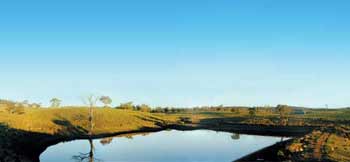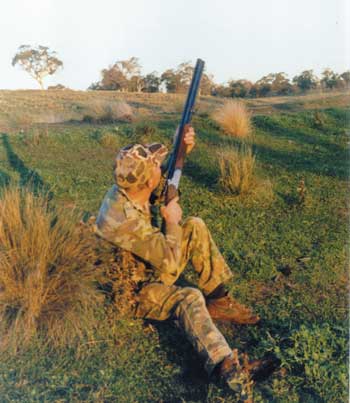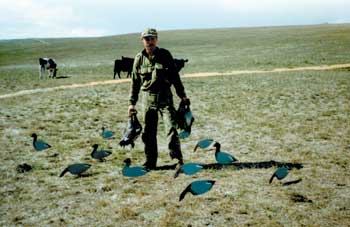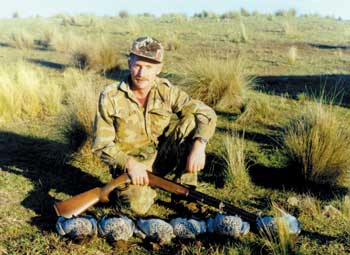Dambusters
by Dr Matt Draisma
Hunter 1
 Dam busting is rated rather poorly by most dedicated wetland duck
hunters. The reality is that in some localities this is the main type
of duck hunting available and can provide an exciting shoot.
Dam busting is rated rather poorly by most dedicated wetland duck
hunters. The reality is that in some localities this is the main type
of duck hunting available and can provide an exciting shoot.
Though not quite as sociable as swamp shoots, it comes without the inconsiderate once-a-year-shooter, squads of greenies, camera-toting media sharks and canoe-paddling animal libbers.
Dam busting is a good way to start beginners on ducks. This first requires a session of trap-shooting practice at a clayshooting range. For experienced hunters this is also good revision.
The next step is to study the location of each dam on the property being hunted and their relationship with the local topography. Discover where the ducks are likely to fly when put up, particularly if you are dealing with wood duck, which when disturbed tend to move only a few dams away. Black duck and teal tend to head further away and are not always so easily followed up, while grey teal, and occasionally wood duck, tend to circle a dam several times once put up, so be prepared for a second round of shots.
Shotguns with automatic ejectors are a distinct advantage in these situations, but pick up the spent cartridges afterwards. Leaving empty cartridges behind is not appreciated by the landowner and, besides, it tips off other hunters to the true potential of your favourite spots.
My shotgun-handling rules are simple. Safety catches must never be used; they can’t be trusted. The gun is normally carried broken and empty. Cartridges are inserted only when preparing to shoot, but the gun remains open. Close the breech and check the selector only when about to shoot. Break the gun immediately after the shooting is finished and unload it. Anyone wishing to close an empty gun, either for storage in a vehicle or gunslip or for carriage on a shoulder sling, must visually satisfy all present that the gun is empty before closing its breech.
 In my opinion, shot sizes No. 6 and No. 7 are best for dam busting
ducks, coupled with fairly open shotgun chokes. It is worthwhile
checking the patterns actually delivered by your shotgun on some sheets
of butcher paper to test the cartridges you intend to use. If the
pattern is evenly distributed without gaps that you can fit a duck
silhouette into and scores about 70 per cent or more of the shot on the
paper, then it will do the job nicely. This knowledge gives you extra
confidence in your shooting.
In my opinion, shot sizes No. 6 and No. 7 are best for dam busting
ducks, coupled with fairly open shotgun chokes. It is worthwhile
checking the patterns actually delivered by your shotgun on some sheets
of butcher paper to test the cartridges you intend to use. If the
pattern is evenly distributed without gaps that you can fit a duck
silhouette into and scores about 70 per cent or more of the shot on the
paper, then it will do the job nicely. This knowledge gives you extra
confidence in your shooting.
The use of non-lead shot will be mandatory in Victoria for all duck shooting, including dam busting. You will have the choice of using steel or bismuth shot. When using steel shot, make sure your shotgun is suitable - otherwise choose bismuth. Steel shot will require you to go down two shot sizes to those for lead or bismuth.
The average range for dam busting is about 20 to 25 metres, well within range for open chokes. Loads of 32 grams are ideal for dam busting. Larger shot sizes are required if you intend to shoot mountain duck, so use No. 2 or BB. I personally find mountain duck a bit tough and prefer the smaller species.
The hunt can be improved dramatically with a few simple precautions:
- Wear full camouflage clothing with a hat;
- Keep low;
- Hide next to cover of some kind to break your outline;
- Don’t look up at circling birds until they are within range.
Any successful hunt requires a plan. Done well, this form of hunting can provide some real challenges and enjoyable quality hunting. Hunt all your dams from the downhill side so that ducks on the dam cannot see you approach. Wood duck frequently graze near the dam or the post lookouts on its wall. These birds can be difficult to stalk and will exercise the full repertoire of your hunting skills.
Use the lie of the land as cover to approach the quarry just as a fox would do. Study the situation carefully, with binoculars if necessary, before proceeding. Be prepared for a long circuit and a bit of crawling along the ground, using gullies and washouts as cover. The greater the effort, the sweeter the spoils, provided of course you shoot well after all that.
The first rule with any duck shooting is to pick out a bird to shoot rather than shooting into the middle of a mob.
Keep your eye on the head of the bird selected, rather than on the body. This lessens the chance of shooting behind. Concentrate only on this duck, interposing your shotgun between your line of sight. Swing to an instinctive lead and fire while continuing to swing with the bird. Birds flying into a pellet pattern drop down dead when hit in the head, neck or chest. There is no time for calculating leads and angles with this type of shooting; just shoot instinctively and your lead will be correct. Picking out a bird is not so easy. Only practice and prior mental conditioning will enforce this habit.
Try not to skyline your body when dam busting, but rather cautiously peek over the wall to locate the birds. Get down after taking your first two shots. The ducks are more likely to circle around and fly past as they depart the scene if they are unable to properly identify the source of the disturbance.
Wait for them to lift into the air before shooting. It is considered unsporting to shoot sitting ducks.
 Remember that shot bounces off surfaces such as water and mud, so
shooting under these circumstances must be done with caution. You must
be extremely aware that a safe background exists for such shots, as the
pellets carry for several hundred yards.
Remember that shot bounces off surfaces such as water and mud, so
shooting under these circumstances must be done with caution. You must
be extremely aware that a safe background exists for such shots, as the
pellets carry for several hundred yards.
These days, thanks to Mr Howard’s gun buy-back, you will only have two shots at the departing birds. If shooting with a companion, you often shoot at the same bird simultaneously, so neither hears the other’s shot, but each sees the bird drop off the end of their barrel and assumes that it’s his.
Don’t laugh, it has happened to me on numerous occasions. I’ve even done a double pair simultaneously - where the second pair of shots was as finely synchronised as the first pair. The down side is that you only end up getting one duck for every two shots, the duck is likely to be full of shot or you never know who really shot it.
It is best to make some agreement about tactics beforehand. For example, the shooter on the right shoots at the birds on his right first and the others similarly shoot at birds according to their position. Also, nominate someone to shoot to lift the birds without showing themselves. The ducks are more likely to circle if put up by a shot from an unseen shooter rather than if they are put to flight by the appearance of a person followed by a volley of shots.
The known flight movements of ducks in any particular area can be very profitably exploited. Placing spare shooters on these flight paths or on known destination dams will provide them with quality overhead shooting. Besides that, it ensures that you get more than just one try at the same group of ducks. Watch carefully where the ducks go and also watch for any late dropouts. Recovery of such birds adds to your success, but is also your duty as a hunter.
Several individual shooters can bust dams and send these birds down to a waiting party sitting over decoys on a larger dam nearby. We have exploited this occurrence on duck opening mornings for many years now. Other dam busters do all the hard work for us. We simply sit and can quite regularly account for 12 or 14 birds out of a limit of 20 between two of us on opening morning.
Where woodies are common, silhouette decoys representing grazing wood duck can be very effective set near dams. Place them side-on to the wind. Ducks tend to land into the wind and they will see the decoys best set at this angle. Decoys are easily made from cardboard, coat-hanger wire and non-glossy poster paints.
Moving between dams can be interesting because there is always the odd hare, fox or rabbit that pops up. This adds variety to both the shooting and the pot. Be prepared and have a few rounds of No 2 or BBs handy for such opportunities.
Another advantage of this type of shooting is that you can clean, dress and store the game as you take it, rather than having an accumulated chore to complete at the end of the day. After dressing recently shot birds, we put ours straight into a freeze box for good meat hygiene.
 Ducks left in the boot of a car or left in the sun for most of the day,
inevitably have a high salmonella contamination risk. The reason is
that full feathers left on ducks act as an insulator, reducing carcass
cooling. Guts left in means that shot, which has penetrated, allows
leakage of bacteria into surrounding meat. When dressing ducks, gutting
can actually result in such bacterial spoilage and contamination.
Salmonella is a common food poisoning bacterium found as a normal gut
inhabitant in ducks.
Ducks left in the boot of a car or left in the sun for most of the day,
inevitably have a high salmonella contamination risk. The reason is
that full feathers left on ducks act as an insulator, reducing carcass
cooling. Guts left in means that shot, which has penetrated, allows
leakage of bacteria into surrounding meat. When dressing ducks, gutting
can actually result in such bacterial spoilage and contamination.
Salmonella is a common food poisoning bacterium found as a normal gut
inhabitant in ducks.
Instead of gutting and plucking, we prefer to immediately skin our ducks. We leave the gut in place. You can detect any gut perforation by way of the brownish-yellow staining evident and can then promptly remove contaminated parts. In plucked birds such a problem often is invisible and goes undetected.
We then proceed to breast the duck, leaving one wing on to satisfy the Victorian game regulations. Leave this wing outside the plastic wrapping to keep the meat clean. The two upper legs are snipped off close to the body using game scissors and added to the pack. And, presto, we have removed 95 per cent of the meat from the duck without ever touching any of the innards.
Having a vehicle set up for the day’s hunt enhances efficiency and professionalism by allowing you to take better care of the game. Besides a cool box, you should carry a waste bucket, paper towels, soap and water, disposable gloves, game shears, freezer bags and something to hang ducks on for dressing.
The wings, lower legs and body parts should be put in the waste bucket and later disposed of, out of sight, in a patch of scrub as fox tucker or effectively buried. The sight of feathers and wings strewn all over the place can be offensive to others, so respect their feelings.
There is more to dam shooting than meets the eye. Try it my way and you will surely enjoy dam busting ducks as much I have. It is as good as you make it.
Captions
Image 2: After taking your first shots, slide in
next to some cover to break your outline, like this tussock. Don’t look
up until you are ready to shoot and sit very still or the ducks will
spot you more readily. These tactics will pay dividends with this type
of hunting. Pick out a bird rather than shooting into the flock. My
under and over is a Lanber 93 EST with spring-loaded ejectors and five
interchangeable choke tubes.
Image 3: Where woodies are common, silhouette
decoys representing grazing wood duck can be very effective set near
dams on opening morning. Place them side-on to the wind. Ducks tend to
land into the wind and they will see the decoys best set at this angle.
They are easily made from cardboard, coat-hanger wire and non-glossy
poster paints.
Image 4: Six fat wood ducks for the freezer,
unusually all ganders. Dr Matt with a sample of the harvest that can
result with a bit of cunning and imagination when dam busting for
ducks. This method of hunting can often be more productive than
shooting on big swamps and doesn’t require a retriever.
